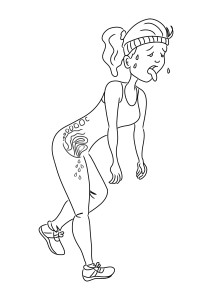Losing the strength in your pelvic floor be it post pregnancy or through other trauma can have a huge impact on you as a person, your relationships and the daily activities you choose to do.
Let’s look at traditional methods!
The sit up….
 Something for you to try first as doing and feeling is better than just reading.
Something for you to try first as doing and feeling is better than just reading.Lie on your back, place your hands on your tummy near the bottom. Now cough. What happens? Does your stomach push out? Does your pelvic floor move down? Something as simple as a light cough can produce a lot of pressure. As you are already on your back, try a traditional abdominal crunch or abdominal exercise of your choice (not too many!). What happens? Can you feel the increase in pressure downwards, outwards, on your back, neck?

Pulling your belly button in toward your spine all day is like squeezing on a tube of toothpaste. As toothpaste will be pressed out of the hole of the tube, so too will the pressure you create attempt to push through any weak point you may have in your core. So if you like hundreds more have been pulling your tummy in and chest breathing to make your self appear slimmer…you have been doing yourself and your diaphragm a disservice! Over time, these weak points can eventually manifest themselves in any number of symptoms of a dysfunctional core.

Doing sit ups, coughing and high impact exercise can prove detrimental to anyone with a core that is unable to manage these pressures, leaving them with one or multiple symptoms of pelvic floor dysfunction: incontinence, prolapse organs, abdominal hernia, vertebral hernia, pelvic instability and poor posture. Understanding that you may have a weak core is the first step to preventing these symptoms from occurring and if you already have symptoms stopping these activities until you restore core strength is super important. You need to balance the hyper with the hypo -Come to a class to find out how you can regain control of your core!